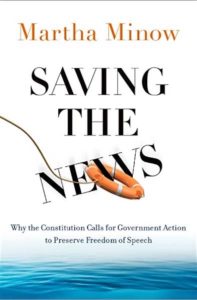Forty-five percent of U.S. newsroom jobs evaporated between 2008 and 2017. In 2016, less than a third of people in one survey trusted mass media. The doomsday facts about the decline of the news industry go on and on. Although more and more communities are becoming news deserts, there’s some hope for the future of the free press that was envisioned in the U.S. Constitution.
In her book Saving the News: Why the Constitution Calls for Government Action to Preserve Freedom of Speech, Martha Minow offers a guide to the current news landscape — the history of news media, the rise of the internet, antitrust law, and the way these topics merge in a perfect storm — and a recipe for changing it. And she does it in a tight 150 pages.

A university professor and former dean at Harvard Law School, Minow is an eminent scholar of Constitutional law, digital communications, democracy, and privatization. She was on the short list of candidates to replace Supreme Court Justice John Paul Stevens in 2010.
Saving the News focuses more on digital platforms and strategies than it does on newspapers themselves. Minow recounts the fast growth of these platforms and the lack of regulations governing them. The ramifications of this regulatory vacuum are many, she writes, and can be blamed — at least in part — for the current political polarization of America. The more politically engaged people are, Minow explains, the more they’re sorted into digital communities in which they’re fed different versions of events depending on their profile — which Minow refers to as “digital gerrymandering.”
The result is divisive: “Large numbers of people live in worlds with barely overlapping news streams,” she writes. Algorithms, playing the role of human editors, can’t be held accountable for decisions about content, yet they determine what gets reported to whom. Facebook and Google users have no idea how decisions about content are made, but they are greatly affected by them.
Since algorithms are used to narrow the information people receive, why can’t they be used to expand it? This brings Minow to a key point: people should be enabled to choose what they do and don’t see. This, she explains, is why the Constitution mandates that the free press be protected: it gives people the power to govern themselves.
Minow isn’t out to demonize technology, but she does go after internet companies, both as culprits and as keys to reviving a healthy, free press. Whether in print or online, what matters is the gathering and sharing of news itself, she writes, which sets her up for a second key point: the press requires special Constitutional attention. A free press is not a widget — an optional add-on to the Constitution. To explain the fundamental role the press plays in a democracy, and why it needs protection, Minow leads the reader on a twisting path through the Fairness Doctrine, net neutrality, and Section 230 of the Communications Decency Act.

Minow offers concrete solutions in 12 examples. To begin, treat digital platform companies as responsible players, she writes — they’re no longer fledgling businesses in need of protection. Next, revitalize public and private protections against fraud, deception, and manipulation. Support, amplify, and sustain public interest news sources at all levels. Require payment for news circulated on social media, produced by professional journalists but circulated by digital platforms at no cost. Some might balk at the idea of paying for news on Facebook or Instagram, but paying for content isn’t unusual in other areas. It may have taken iTunes and Spotify time for their pricing schemes to defeat piracy, but they eventually succeeded. Why can the same not be done for news?
Minow’s book should be required reading in media literacy and civics classes — and, really, for any voter or social media user. The writing is clear and concise, accessible to anyone who puts her mind to it. But Saving the News will be most valuable to those who care about the Constitution and the profession of journalism.
One aspect of the news ecosystem Minow doesn’t discuss, and perhaps should have, is that many local newspapers are succeeding. Yes, journalists are being laid off and papers are being shuttered — but that is happening almost entirely at chains owned by private-equity conglomerates like Alden Global Capital and the former GateHouse, now Gannett. Around the country, citizens are buying back their local papers from corporations, others are creating nonprofit start-ups, and hyperlocal news outlets are thriving.
“Ad revenues migrate to digital companies,” Minow writes. But that’s not necessarily the case at smaller papers in particular. In fact, print ads for local businesses still produce the major share of revenue for many papers. A recent World Advertising Research Centre Global Ad Trends study predicted that digital ad spending in 2021 would be up more than 10 percent, while print ad spending would rise 12 to 14 percent.
Instead, Minow focuses on establishing the history and facts from which to launch solutions. She argues that those solutions must be enacted in courtrooms and by digital companies, and that it’s time for the government to step up.
“The government contributed to the dangers we currently face,” writes Minow, matter of factly. The Constitution is her tool for exposing the government’s failures and the reasons why it must take on the task of addressing the present danger.
